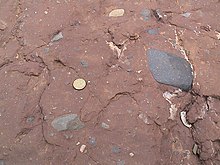Cryogenian
| Cryogenian | |
|---|---|
| ← | Transition from cyanobacterial to algal dominated world.[3] |
| ← |
Major Glacial period |
Axis Scale: Millions of Years Ago (
- Worldwide distinct cap carbonates.
- Beginning of a distinctive pattern of secular changes in carbon isotopes.
(5 times pre-industrial)
(9 °C below modern)
million years ago) |
The Cryogenian (from
The Cryogenian was a time of drastic biosphere changes. After the previous
Ratification
The Cryogenian Period was ratified in 1990 by the International Commission on Stratigraphy.[7] In contrast to most other time periods, the beginning of the Cryogenian is not linked to a globally observable and documented event. Instead, the base of the period is defined by a fixed rock age, that was originally set at 850 million years,[8] but changed in 2015 to 720 million years.[6]
This could cause ambiguity because estimates of rock ages are variable and are subject to laboratory error. For instance, the time scale of the
Currently, there is no consensus on what global event is a suitable candidate to mark the start of the Cryogenian Period, but a global glaciation would be a likely candidate.[8]
Climate
The name of the geologic period refers to the very cold global climate of the Cryogenian.
Characteristic glacial deposits indicate that Earth suffered the most severe ice ages in its history during this period (Sturtian and Marinoan). According to Eyles and Young, "Late Proterozoic glaciogenic deposits are known from all the continents. They provide evidence of the most widespread and long-ranging glaciation on Earth." Several glacial periods are evident, interspersed with periods of relatively warm climate, with glaciers reaching sea level in low paleolatitudes.[9]
Glaciers extended and contracted in a series of rhythmic pulses, possibly reaching as far as the equator.[10]

The Cryogenian is generally considered to be divisible into at least two major worldwide glaciations. The
Paleogeography
Before the start of the Cryogenian, around 750 Ma, the
Eyles and Young state, "Most Neoproterozoic glacial deposits accumulated as glacially influenced marine strata along rifted continental margins or interiors." Worldwide deposition of dolomite might have reduced atmospheric carbon dioxide. The break up along the margins of
Cryogenian biota and fossils
Between the Sturtian and Marinoan glaciations, global biodiversity was very low.[13]
Fossils of
The end of the period also saw the origin of heterotrophic plankton, which would feed on unicellular algae and prokaryotes, ending the bacterial dominance of the oceans.[21]
See also
- Timeline of glaciation – Chronology of the major ice ages of the Earth
References
- ^ doi:10.1144/M36.1.
- ^ PMID 29134193.
- ISSN 2397-8554.
- ISSN 0705-3797.
- . Retrieved 6 December 2020.
- ^ a b "Chart". International Commission on Stratigraphy. Archived from the original on 13 January 2017. Retrieved 14 February 2017.
- . Retrieved 7 September 2013.
- ^ a b "GSSP Table - Precambrian". Geologic Timescale Foundation. Retrieved 7 September 2013.
- ^ ISBN 0521548039.
- ^ Dave Lawrence (2003). "Microfossil lineages support sloshy snowball Earth". Geotimes.
- doi:10.1038/ngeo214.
- ^ Hoffman, P.F. 2001. Snowball Earth theory
- ^ PMID 31636318.
- S2CID 239629114. Retrieved 11 September 2023.
- S2CID 54636062.
- S2CID 4314662. Archived from the original(PDF) on 2018-05-08. Retrieved 2009-04-15.
- doi:10.1038/ngeo934.
- ^ "Discovery of possible earliest animal life pushes back fossil record". 2010-08-17.
- hdl:11343/52679.
- ^ "Palaeos Proterozoic: Neoproterozoic: Cryogenian".
- ^ Fossil fats reveal how complex life kicked off after Snowball Earth phase
Further reading
- "Cryogenian Period". GeoWhen Database. Archived from the original on December 2, 2005. Retrieved January 5, 2006.
- James G. Ogg (2004). "Status on Divisions of the International Geologic Time Scale". Lethaia. 37 (2): 183–199. .
- Brain, C. K.; Prave, A. R.; Hoffmann, K. H.; Fallick, A. E.; Herd, D. A.; Sturrock, C.; Young, I.; Condon, D. J.; Allison, S. G. (2012). "The first animals: ca. 760-million-year-old sponge-like fossils from Namibia" (PDF). .
- Hoffman, Paul F.; Abbot, Dorian S.; et al. (November 8, 2017). "Snowball Earth climate dynamics and Cryogenian geology-geobiology". Science Advances. 3 (11). American Association for the Advancement of Science: e1600983. S2CID 1465316.
External links
- The Time Travellers Guide to Australia (2012) at IMDb
- Miracle Planet : Snowball Earth on YouTube(2010s) BBC/CBC/NHK

